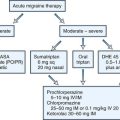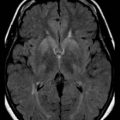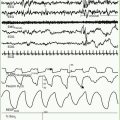Chapter 52C Cancer and the Nervous System
Clinical Features and Complications
Headache
Simple analgesics are usually adequate to treat headache related to impingement on pain-sensitive structures in the brain, but in rare circumstances, opioid analgesics may be required. In general, attempts should be made to treat the underlying tumor and associated vasogenic edema in order to relieve the headache. In patients without hydrocephalus, this treatment typically includes surgical resection and may include radiation and/or chemotherapy as well as the use of corticosteroids to treat vasogenic edema (see Cerebral Edema, later). When hydrocephalus is the cause of increased ICP, ventricular shunting or removal of the mass lesion obstructing the ventricular system is the most effective way to eradicate headache.
Other Cerebral Symptoms
Cognitive abnormalities that develop after systemic cancer or brain tumor treatment can be the result of neurotoxicity of those treatments, especially whole-brain radiation and systemic or intrathecal chemotherapy. Brain radiation can result in acute symptoms of fatigue and, rarely, temporary cognitive impairment. Early delayed reactions include cognitive impairment and/or somnolence, typically beginning within a few weeks to months of the completion of radiation, and are reversible. Late delayed effects of cognitive impairment, sometimes with gait abnormalities and sphincter incontinence, typically begin several months or longer after the completion of radiation and are irreversible (Dropcho, 2010). The incidence and cause of cognitive impairment and fatigue, termed chemobrain, is debated. This syndrome is reported to occur during and for several months following administration of standard systemic chemotherapy, typically administered for breast cancer. The most common persistent brain tumor–related cognitive impairment associated with chemotherapy is leukoencephalopathy following high-dose systemic or standard-dose intrathecal methotrexate. The risk is significantly greater when the chemotherapy is combined with brain irradiation (Correa et al., 2007).
Routine neurological examination, including testing of cognitive function, Mini-Mental State Examination, and neuropsychological testing, are all useful to confirm subcortical dementia in treatment-related neurotoxicity. In patients who have received whole-brain radiation, testing of hypothalamic and pituitary function by serum hormone tests is indicated to exclude hormonal deficiency as a contributing factor. Contrast-enhanced T1-weighted and FLAIR MRI sequences are also indicated to search for periventricular white-matter changes consistent with delayed leukoencephalopathy and for recurrence of brain tumors; delayed cognitive impairment may also be an early predictor of tumor progression (Brown et al., 2006).
Fatigue and cognitive impairment occurring during brain irradiation is self-limited and does not require treatment. Subacute cognitive impairment or somnolence responds well to corticosteroids. Delayed leukoencephalopathy is irreversible, but some improvement is possible with medical therapy. Methylphenidate can be beneficial in treating cognitive impairment as well as motor dysfunction and is well tolerated in these patients. A recent trial of donepezil administered to patients several months after the completion of brain radiation demonstrated improved attention/concentration and verbal and figural memory as well as improved emotional and social functioning (Shaw et al., 2006). In the author’s experience, memantine is also effective in some patients. Memantine is now being tested in a national multicenter clinical protocol as a preventive medication when given with whole-brain radiation for brain metastasis. Modafinil is used to treat cancer-related fatigue, including that associated with brain tumors, and when it is effective, mental clarity is also improved. Ventricular shunting can be effective in the management of treatment-related leukoencephalopathy, even when the ventricles are not significantly enlarged. Cognitive rehabilitation has not been studied systematically in brain tumor patients, but it may have a beneficial role, especially for patients with an expected long-term survival.
Seizures
The management of seizures in the brain tumor patient presents unique considerations compared with patients who do not have a brain tumor. Brain tumor resection can be effective in patients with low-grade primary brain tumors, especially when the resection includes the epileptic focus. Intraoperative electrocortigraphy may be required to establish the seizure focus. Treatment of the tumor with brain irradiation has proven efficacy in reducing seizure frequency, as has administration of systemic chemotherapy. The mechanism for seizure reduction from these treatments is not known. The majority of patients with brain tumor–associated epilepsy require antiepileptic drug therapy. Antiepileptic drug absorption, protein binding, and metabolism and interaction with chemotherapy administered to treat the brain tumor, and corticosteroids to treat vasogenic edema, are critical considerations. The most common metabolic pathway for biotransformation of many antiepileptic drugs and chemotherapy is the cytochrome P450 system. Antiepileptic drugs that induce P450 hepatic metabolism (e.g., phenytoin, carbamazepine, phenobarbital) induce the metabolism of many chemotherapeutic agents and decrease the effectiveness of chemotherapy (Vecht et al., 2003). In contrast, antiepileptic drugs that decrease hepatic metabolism (e.g., valproic acid) will lead to higher levels of chemotherapy, resulting in a greater risk of toxicity (Oberndorfer et al., 2005). Attention should also be paid to the dose of dexamethasone when patients are receiving P450-inducing antiepileptic drugs that increase the metabolic clearance of dexamethasone; higher doses may be required.
When possible, the use of a non-P450-inducing antiepileptic drug is recommended. Several published studies indicate that levetiracetam is effective and well tolerated in brain tumor patients with epilepsy (Usery et al., 2010). Despite diligent attention to the selection of appropriate antiepileptic drugs and patient compliance, complete seizure control is difficult to obtain in patients with brain tumors.
Despite the high frequency of seizures during the lifetime of the brain tumor patient, prophylactic treatment with antiepileptic drugs is not recommended except in unusual circumstances. For example, some clinicians treat patients with melanoma brain metastases prophylactically because of the very high risk of seizures associated with this histology. However, no evidence exists that prophylactic treatment prevents seizure onset (Glantz et al., 2000). In addition, patients with a brain tumor are at risk for more severe and more frequent adverse effects of antiepileptic drugs such as cognitive impairment, sedation, myelosuppression, hepatic dysfunction, and dermatological reactions. The dermatological reactions can be particularly severe when brain radiation is administered.
Brown P.D., Jensen A.W., Felten S.J., et al. Detrimental effects of tumor progression on cognitive function of patients with high-grade glioma. J Clin Oncol. 2006;24(34):5427-5433.
Correa D.D., Maron L., Harder H., et al. Cognitive functions in primary central nervous system lymphoma: literature review and assessment guidelines. Ann Oncol. 2007;18(7):1145-1151.
Dropcho E.J. Neurotoxicity of radiation therapy. Neuro Clin. 2010;28(1):217-234.
Glantz M.J., Cole B.F., Forsyth P.A., et al. Practice parameter: anticonvulsant prophylaxis in patients with newly diagnosed brain tumors. Neurology. 2000;54:1886-1893.
Oberndorfer S., Piribauer M., Marosi C., et al. P450 enzyme inducing and non-enzyme inducing antiepileptics in glioblastoma patients treated with standard chemotherapy. J Neurooncol. 2005;72(3):255-260.
Shaw E.G., Rosdhal R., D’Agostino R.B.Jr., et al. Phase II study of donepezil in irradiated brain tumor patients: effect on cognitive function, mood, and quality of life. J Clin Oncol. 2006;24(9):1415-1420.
Usery J.B., Michael L.M.2nd., Sills A.K., et al. A prospective evaluation and literature review of levetiracetam use in patients with brain tumors and seizures. J Neurooncol. 2010;99(2):251-260.
Vecht C.J., Wagner G.L., Wilms E.B. Treating seizures in patients with brain tumors: drug interactions between antiepileptic and chemotherapeutic agents. Semin Oncol. 2003;30(6 Suppl 19):49-52.







